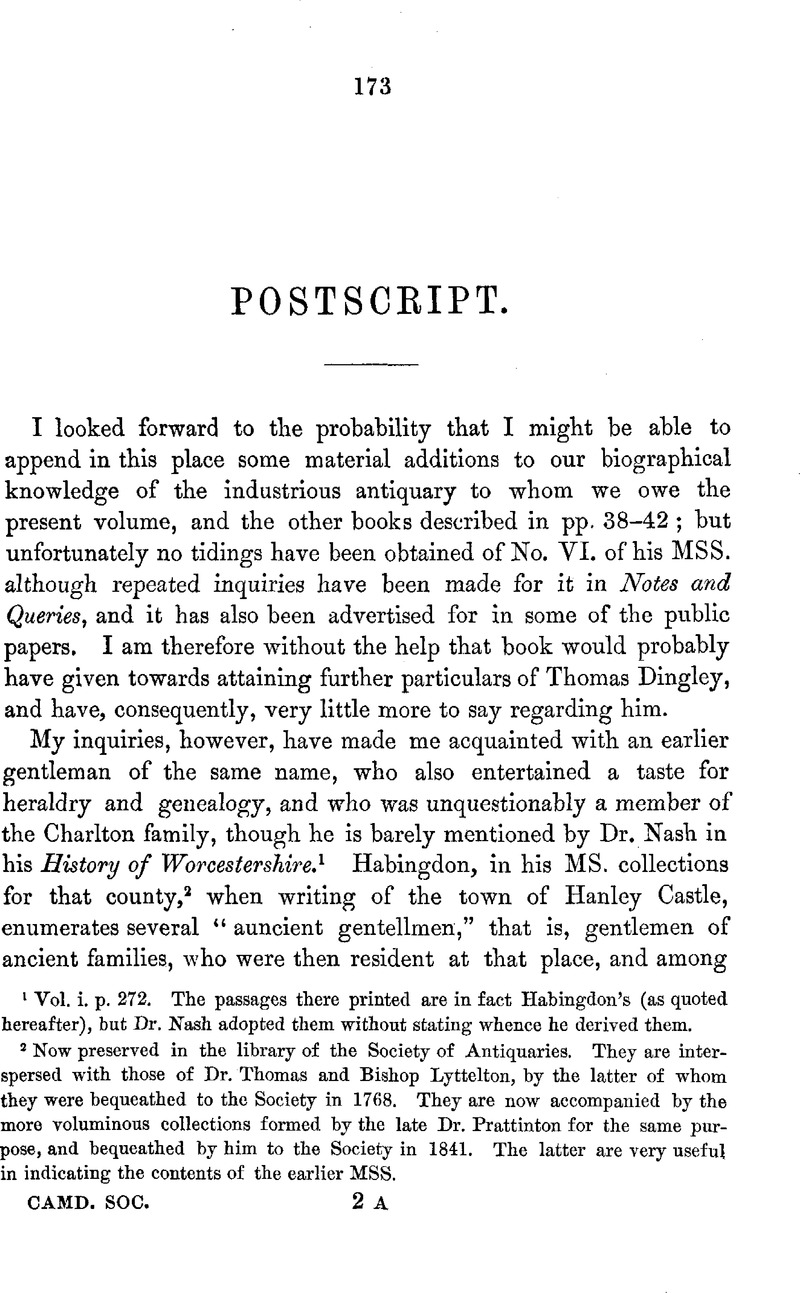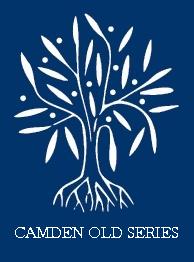No CrossRef data available.
Article contents
Postscript
Published online by Cambridge University Press: 24 December 2009
Abstract

- Type
- History from Marble
- Information
- Copyright
- Copyright © Royal Historical Society 1868
References
page 173 note 1 Vol. i. p. 272. The passages there printed are in fact Habingdon's (as quoted hereafter), but Dr. Nash adopted them without stating whence he derived them.
page 173 note 2 Now preserved in the library of the Society of Antiquaries. They are interspersed with those of Dr. Thomas and Bishop Lyttelton, by the latter of whom they were bequeathed to the Society in 1768. They are now accompanied by the more voluminous collections formed by the late Dr. Prattinton for the same purpose, and bequeathed by him to the Society in 1841. The latter are very useful in indicating the contents of the earlier MSS.
page 174 note 1 History of Northamptonshire, by Bridges and Whalley, vol. ii. p. 305.
page 174 note 2 “In 1353 Henry Duke of Lancaster granted the manor of Downham to John de Dyneley, one of a family lately settled at Clitheroe, and who had probably recommended themselves by their services, but originally from Dyneley in Cliviger.” (Whitaker, History of Whalley. 3rd edition, 1818. 4to. p. 297.) Dr. Whitaker, (ibid. p. 350), gives six generations of the Dyneleys of Cliviger, which is another township in the parish of Whalley, extending from Henry de Dyneley living temp. Hen. III. to Margaret their daughter and heiress, married to Henry Townley, circ. 8 Hen. V.; and he also states in a note, on the authority of Thoresby, that the Dyneleys of Bramhope were a branch from Downham. (Ibid. p. 350.)
“Some distance hence [near Otley] is Bramhope, the seat of the antient family of the Dinely's, of which Robert Dinely, esq. (deceas'd not many years since in a good old age, having seen four generations of most of the nobility and gentry), erected a chapel here with a competent endowment.” Bishop Gibson, in his edition of Camden's Britannia, 1722, col. 868.
page 175 note 1 See three letters from Mr. Henry Dingley to Sir Simon Archer, printed in The Herald and Genealogist, vol. v.
page 175 note 2 Copied by Thomas Dingley in p. ccxxiii. of the present volume.
page 176 note 1 See note in p. 120.
page 176 note2 See his grandfather Nicholas in the pedigree, p. 24. His father Thomas was also comptroller of the port of Southampton, and the note (') in p. 25 is not incorrect, though it was left somewhat deficient in not including a remark that Thomas had succeeded his father Nicholas in office.
page 176 note3 See the references in the Index. On some pages I suspect we have passages in Alye's own handwriting: see particularly the pages which relate to the cathedral church of Lichfield.
page 1764 note 4 See a certificate bearing his signature, and dated “Worcester the 2d xber, 1678,” in the volume I. 25, in Coll. Arm. His first wife was Eleanor daughter of Thomas Vaughan of Tewkesbury, esq., and Dingley has copied her (Latin) epitaph in that her p. cccxlviii. In p. 125 I have misinterpreted the word “domini” as signifying that her father was a knight.
page 177 note 1 This was the gentleman mentioned by Dingley in p. cccxlv. “because he was a respecter of ye monuments of the dead,” and had kept the Bryan chapel at Tewkesbury in repair at his own charge ; and who has been further noticed in p. 124. But as he was living in 1623, Dingley was mistaken in supposing that the brief inscription “1616. E. ALYE.” commemorated his interment. It probably marked the grave of a child, and very likely that of Edward, his second son by his first wife.
page 177 note 2 These particulars were communicated to me by the late Mr. Richard Johnson, town clerk of Hereford, whose recent work on the early history of that city I have mentioned in p. 149. He died suddenly on the 13th April, 1868, aged 71.
page 177 note 3 The Vicars Choral of Hereford were incorporated anew by charter of Queen Elizabeth in 1583. For more than a century after, they occasionally received strangers into their college ; as on the 27th June, 1678, the Rev. Philip Lewis, a canon (to whom Dingley has dedicated his drawing of the west front of the cathedral, p. clxvi.), was admitted a commoner. The custom was abolished in the year 1689; but renewed in the latter part of the last century. Some of the most distinguished names among the commensals are enumerated in Dunoumb, i. 589.
page 179 note 1 See Mr. Baker's edition of the Notitia Cambro-Britannica, p. 115.
page 179 note 2 Edit. Baker, p. 114.
page 179 note 3 Ibid. pp. 124, 127.
page 179 note4 Dingley speaks of “my Collections of Hereford” in his Notitia Cambro-Britannica, edit. Baker, p. 101.


